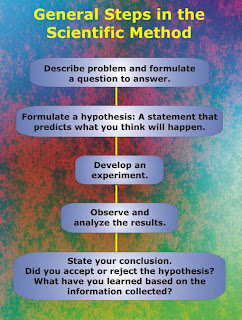Definitions (All from “Human Biology” by Mader, Sylvia S.)
Biology: Scientific study of life. Human biology is a specialty in biology.
Scientific Theories: An idea that is supported by a broad range of observations, testing, hypotheses, and coming to conclusions.
Scientific Method: Process of learning by making observations, testing hypotheses, and coming to conclusions.
Here is an image from http://lowimpactdevelopment.org/school/images/scimethod2.jpg that is a very simple outline of the scientific method.
There are five important parts of the method. They often vary in terminology, but essentially, all steps are the same. These include:
Observations, which is figuring out the problem.
Hypothesis, making a statement as to what you believe the outcome will be.
Experiment, conduct experiments to prove or disprove your hypothesis.
Observe or Conclude, analyze your results.
Scientific theory, explain your conclusions and determine if your experiments supported your hypothesis.
I want to know why my boyfriend always burns dinner. (Observations)
So my question is, Why can’t my boyfriend cook? (Developed Question)
He can’t cook because he doesn’t know how to follow directions. (Hypothesis)
For my experiment, I will ask him to cook dinner using a cookbook. My other experiment will involve him cooking but me giving him directions. (Experiment)
During the first experiment, my boyfriend read the directions, but chose not to measure anything. The food came out runny and overcooked. The second experiment, I instructed him on how to cook the recipe. He listened to what I said and measured. This time, he became distracted by Facebook and let it cook too long, so it burned. (Observe/Analyze)
After analyzing my evidence, I have concluded that he can’t cook because he becomes easily distracted and has a hard time following written directions. (Conclude)
My experiments supported my hypothesis and then some because it was also noted that he has a short attention span. (Conclude/Scientific Theory
Research
Now let’s take a look at the different types of research used in scientific studies. Here is a chart from the textbook “Nutrition: concepts and Controversies” by Sizer, Frances and Whitney, Ellie that has included important terms often used in a scientific studies.
| Type of Research | Description |
| Blind Experiment | An experiment where the subjects don’t know if they are part of the experimental group or the control group. |
| Case Studies | Studies of individuals, in a clinical setting where researchers can observe treatments and apparent effects. |
| Epidemiological Studies | Studies of populations, usually by polling and in the natural environment. |
| Intervention Studies | Studies of populations in which observation is accompanied by experimental manipulation of some population numbers. |
| Laboratory Studies | Studies that are performed in tightly controlled situations and are designed to pinpoint causes and effects. |
| Experimental Group (Definition) | People or animals who receive the actual treatment. |
| Control Group (Definition) | A group of individuals who are similar in all possible respects to the groups being treated in an experiment but who receive a sham treatment instead of the real one. |
| Placebo (Definition) | A sham treatment where a harmless medication (or maybe a Tic-Tac) is used on the control group. |
Conclusion: After taking time to look through this information, hopefully you have learned the very basics of what goes into a scientific study and different types of research. In some studies, it is necessary to observe a cell. In order to do so, one must use a microscope. In the next section, you will see images from an online microscope simulator. The images are of a cheek smear. The section will also cover microscope basics, some important tips, and how different parts of the microscope work.

No comments:
Post a Comment